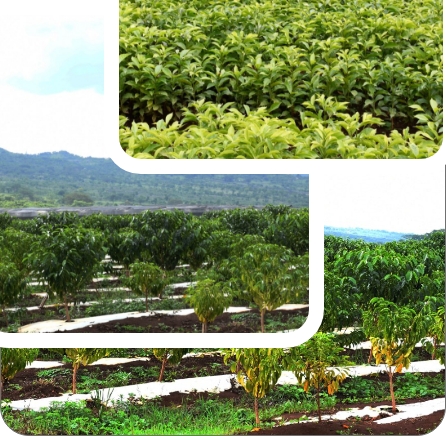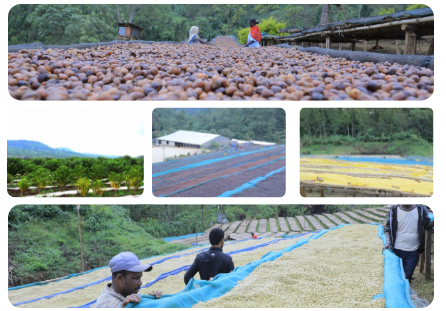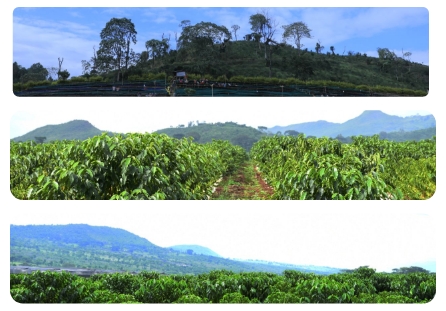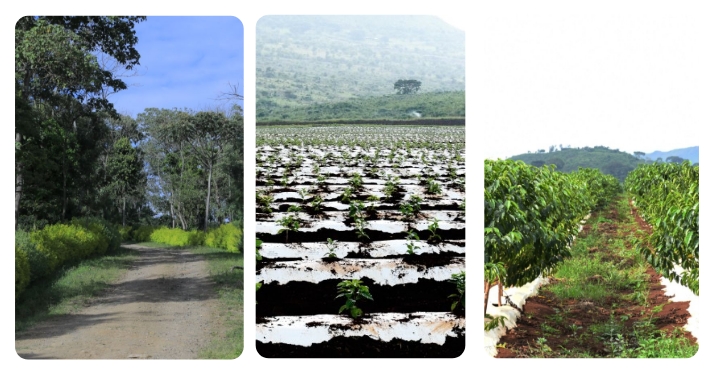Bale Mountain.

The Bale Mountains are a mountain range in southeastern Ethiopia. Located in the Oromia Region, the Bale Mountains form part of the Ethiopian Highlands. The Bale Mountains include Mount Batu and Tullu Dimtu, which is the second-highest peak in Ethiopia. Bale Mountains National Park, which is situated about 93 miles east of Shashamene and 248 miles from Addis Ababa, and occupies an area of about 860 square miles, is also located within the Bale Mountains. The boundary of the BMNP lies within five woredas (districts): Adaba (west), Dinsho (north), Goba (northeast), Delo-Mena-Angetu, and Harena-Buluk (southeast). Bale Mountain experiences mild temperatures throughout the year. Since it is a high-altitude region, the temperature can approach zero at night.
More Information on Bale Mountains
Northern grasslands (Gaysay Grasslands)
The Northern grasslands, spanning the Web and Danka Rivers, are situated to the south of the Bodeti Mountain and north of Adelay ridge, and northwest of Dinsho. The altitude of the area ranges from 3,000 m to 3,500 m, pushing the upper limit for tree growth. The land is flat, dominated by swamp grasses and sedges, especially of the Cyperus and Scirpus genera, and becomes muddy during the rainy season. Higher areas are scrubby with African or wild wormwood (Artemesia afra) and Cape gold (Helichrysum splendidum), one of more than ten species of everlasting flower found in Bale. Both are important sources of food for the mountain nyala and sources of shelter for other animals. Hagenia abyssinica trees flower from November through February; female trees boast an impressive red bloom. Wild fennel also grows here.
The Northern grasslands are the best place for viewing the endemic mountain nyala - sometimes up to 50 in a herd. Also ever-present, bohor reedbuck, plays an important role in the ecosystem as they are the only grazers in this area of the park. Other mammals that are commonly seen are warthog, grey duiker, serval, and golden (common) jackal, along with the spotted hyena at night.
Birds that can be seen include the Abyssinian longclaw, Winding cisticola, Marsh harrier, Abyssinian ground hornbill, Spot-breasted plover, Rouget's rail, wattled ibis, Abyssinian catbird, and many more.
Juniper Woodlands (Park Headquarters)
The juniper woodlands cover the northern slopes of the Bale massif, reaching from Dodola to Dinsho. These woodlands are under the intense pressure of grazing, hindering the growth of new trees. Hagenia abyssinica and African juniper (Juniperus procera) dominate the woodlands. At the upper limit of their distribution, the juniper trees are smaller than that it is present in other areas of the park. In contrast, the Hagenia trees can grow to be massive, with a blooming period from November to February. St John's wort (Hypericum revolutum) is also common in the woodlands, growing as shrubs near the lower edge and reaching a height of 5m in the upper tree line. They are easily recognizable by their bright yellow flowers, which bloom throughout the year and are the major source of nectar for the honey produced in the area. Also present is the only indigenous rose to Africa (Rosa abyssinica), which has fragrant white flowers.
Mountain nyala, Warthog, Menelik's bushbuck, Clobus monkey, and Olive baboon can be spotted in the area.
Birds to look for include the wattled ibis, Abyssinian catbird, white-backed black tit, Abyssinian ground thrush, gold-mantled woodpecker, red-breasted wryneck, thick-billed raven, and many more.
Afroalpine Meadows (Sanetti Plateau & Upper Web Valley)
A small amount of plant diversity can be seen here due to the altitude. However, one of the notable plant species is the giant lobelia found from 3,100 m to 4,377 m growing to a maximum height of 6 m. On the plateau stands Tulu Dimtu at 4,377 m. This is the second tallest mountain in Ethiopia and the tallest in Bale.
Found staggeringly at high densities in Afroalpine meadows (average of 2,500 kg per km2) Afroalpine rodents (mice, rats, and molerats) dominate the cold and seemingly barren plateau. Look specifically for the giant molerat (endemic to the Bale Mountains), rock hyrax, and Starck's hare. The plateau is also home to Ethiopian wolves and a trip to the plateau all but guarantees a sighting of this charismatic carnivore. The plateau hosts a large number of raptors that feed on the sizeable rodent population. Look for augur buzzards; Verreaux's, tawny and steppe eagles; lanner falcons; kestrels; and the lammergeyer or bearded vulture. This is also the most southern resident and breeding area in the world for golden eagles. The lakes, rivers, and swamps attract many Palearctic waders. Look for the endemic blue-winged goose (the rarest and most isolated goose in the world); spot-breasted plover; and ruddy shellduck (like the golden eagle, the ruddy shellduck population is unique and isolated). Additionally, the red-billed chough is the most southern population in Africa. Several pairs of wattled cranes are also present on the plateau - the northernmost population in Africa.
Erica Belt: Moorlands and Forest
Located directly above the tree line, from 3,400m to 3,800m, is a belt of heather made up of species of the Erica and Phillippa genera, dominated specifically by Erica arborea (tree heath), a shrub common throughout the world that grows to staggering proportions in Bale - up to 5m on the edge of the tree line. These forests are a fairytale wood of giant heather dressed in moss and an old man's beard (a lichen). These trees are highly endangered and quite rare in Ethiopia. The most accessible example of this type of forest is on the road that crosses the Sanetti plateau, 100 meters above Rira.
Mountain nyala, Menelik's bushbuck, and grey duiker live in the area are relatively large in numbers, but are hard to spot due to vegetation densities. Klipspringers and hyraxes are also common here. The Bale Mountains are the only area where both male and female klipspringers have horns.Look for moorland and chestnut-naped francolins, Alpine chat, and Rouget's rail.
Harenna Forest
The southern and largest area of the park consists of the second largest forest in Ethiopia; the Harenna forest. Along with the adjacent State- and community-managed forest outside the park, it constitutes an area of over 4,000 km2. It is also the largest cloud forest in the country. The road from the plateau takes you down the Harenna escarpment and into the forest. Mountain bamboo grows within the forest, particularly on steep slopes. Rubus steuderi, a member of the blackberry family, grows along the road from April to June. The upper area of the Harenna forest is a wet cloud forest with an extensive bamboo belt, while the lower parts are drier mountain forests. At about 2,200 m as the slopes become gentler, larger trees up to 30 meters tall appear, and the canopy closes. These include fern pine (Podocarpus gracilior) and fig trees (Ficus spp.) of massive girth. Branches are covered with dense epiphytes. In the lower areas of the forest, wild forest coffee (Arabica sp.) grows.
Because the forest is so dense and clearings are few and far between, the elusive animals of the forest have little trouble staying hidden. Black-and-white colobus monkey, olive baboon, warthog, and Menelik's bushbuck are common. With a little luck and perseverance, you might see a giant forest hog, a bush pig, or an endemic Bale monkey. Clearings are the best places to look for lions, leopards, and African wild dogs. Genet, civet, porcupine, and hyena are all active at night.
Birds of the Harenna forest are equally elusive. Look for the Abyssinian hill babbler, Abyssinian crimson-wing, Ayre's hawk-eagle, silvery-cheeked hornbill, black-winged lovebird, Abyssinian oriole, yellow-fronted parrot, white-cheeked turaco, and Narina trogon. A wide range of migrant birds can also be spotted, including Palearctic warblers.
Culture & History

The Bale Mountains are the ancestral home of the Oromo, the largest single ethnic group in Africa. Living as pastoralists and farmers, the population grew quickly and expanded to different corners of the country at the beginning of the 16th century.
Little is known about the Oromo people of the area and how they settled here. They are a part of the eastern Cushitic people stemming from a branch of the Caucasoid race (which includes Western Asians, Arabs, and Europeans), and are scattered from Shoa in Ethiopia's north, to Mombasa in Kenya to the south. Three thousand years ago, they passed on practices - such as the initiation ceremony of circumcision and the habit of not eating fish - to the Nilotic peoples in the West. Furthermore, they incorporated ideas of the Gada system and cattle husbandry into their own society. The Gada system is based on the principles of classifying a society into 11 functional grades, each of which has its own special roles and status.
Currently, people subsist mainly on agriculture. They follow a traditional transhumance system known as the Godantu system, a key feature of traditional human use of the Bale Mountains. In this system, livestock, particularly cattle, are sent to higher grazing grounds during the months when crops grow in lower altitudes, or into the forest for shade during the dry season. However, this should not be confused with the cattle movements that are a consequence of the loss of grazing land outside of the park, thus forcing cattle into the park to graze.
Bale houses are circular in shape and locally referred to as 'mana citaa'. Juniper and sometimes eucalyptus are used to make the walls and roofs. The roof is covered with thatched grass cut from citaa (tussock grass) or stubble, specifically barley, and supported by a wooden pillar, which stands in the middle of the floor. The house is divided into portions by walls made of bamboo or mud mixed with barley or grass stubble.
Population
The population of the Bale zone is approximately 1.5 million. The town of Robe is about 48,000, Goba 33,000, and the Dinsho Woreda (district) 40,000. The people of the region are predominantly Oromo-speaking farmers and cattle herders. Famed for their equestrian skills, they are often seen galloping atop their horses across the wide-open country - a stirring and romantic spectacle.
Language
Afan Oromo is the official language of the Oromo people. It belongs to the Cushitic language family and serves as a sort of lingua franca for over 25 million Oromos. However, most of the people in the Bale Mountains also speak some Amharic.
Religion
The predominant religion in the Bale Mountains is Muslim (77 percent), followed by Orthodox Christian (20 percent), and Protestant (one percent).
Bale Mountain Farm

Bale Mountain Farm is located in Arsi - Bale Mountains belt which forms the south-eastern Ethiopian Highlands, 3000 meters above sea level. The farm extends from 1,800 to 2,100 MASL and the land continues up to the mountain all the way to 2,200 MASL, a nature reserve home to birds and animals. The Bale farm is surrounded by two rivers that flow to the Wabe Shebelle River and the forest mountains. The eco-friendly and sustainable coffee production practices carried out at the Bale farm are helping the community that lives around the farm. Covered and protected by a number of large shade trees, the coffee farm plays a great role in water conservation and soil fertility enhancement. The coffee collected from this farm is incredibly pure, aromatic, dense, uniform, and tastes extremely delicious. The bluish color of the cherry indicates its high quality and brings distinctive flavor profiles of nectar, fresh raspberries, lemonade (lemon balm), peach, and also the chocolate and juicy blends of coffee.
The farm is engaged in social responsibility activities like the construction of local roads, the establishment of the nursery, free distribution of the coffee seedlings, construction of schools, and financial support for the community to face the challenges during the off-season. Kerchanshe considers and presents the Bale mountain farm before the communities as a productive and hopeful place to work and live.
Bale mountain coffee farm is owned by Mr. Israel Degefa, the CEO of Kerchanshe Trading PLC, the largest producer and exporter of coffee in Ethiopia. Israel was gifted with this farm by his grandmother Mrs. Wagayehu Bekele Debela. She used to grow coffee traditionally for domestic consumption, along with wheat and barley. During harvests, she usually sends coffee from her own farm to the entire family as a present.
Israel reminisces how he used to help his grandmother to take care of the farm as well as other household chores. He recalls how growing up with his grandmother had a profound influence on his life, defining his character and teaching him about life, culture, and most importantly coffee. As she knew how passionate he was about coffee, she decided to give him her traditional farm as a present.
Israel claims that he reformed a lot of things on this farm after receiving it from his grandmother. This includes implementing drip irrigation to deal with climate and environmental changes and planting only high-quality coffee seedlings without the application of chemicals, fertilizers, or pesticides to produce the purest coffee beans.
Bale Mountain Farm comprises a world-class guest house with a magnificent view for coffee lovers around the world who want to experience the exceptionality of the farm. While Mr. Israel invests and installs a high-tech system, it is also very imperative for him to preserve the traditional norms of coffee as they have been handed over from generation to generation.
| Region | Oromia |
|---|---|
| Zone | Arsi |
| District | Nensebo |
| Village | Munessa |
| Altitude | 1950-2200 masl |
| Temperature during day time | 18 ° C to 25 °C |
| Temperature during night time | 14 ° C to 20 ° C |
| Soil type | Forest soil and volcanic red that is rich in organic matter |
| Average rain fall per year | 1250-1800 mm |
| Harvest Time | Oct - Dec |
| Harvesting method | Selective hand-picking of fully red ripe cherries |
| Coffee Varieties used in the farm | (74-140, 74-110, Geisha and local well adapted cultivars) |
| Shade Trees | Albizia gummifera, permanent fruit trees, false banana, and legume trees |
| Processing Methods | Washed/wet processing and natural sun drying method |
Cupping Profile
Flavor
The brewed cup is distinguished by its well-balanced body (mouth feels) and noticeable spicy flavors, often fruit-toned, pleasantly sweet and vibrant with floral overtones, and a lingering taste of Lemon grass.

Body
Medium to full body
Acidity
Medium to medium pointed or sharp pointed
Raw
Small to medium-sized bean, greenish, greyish in color


